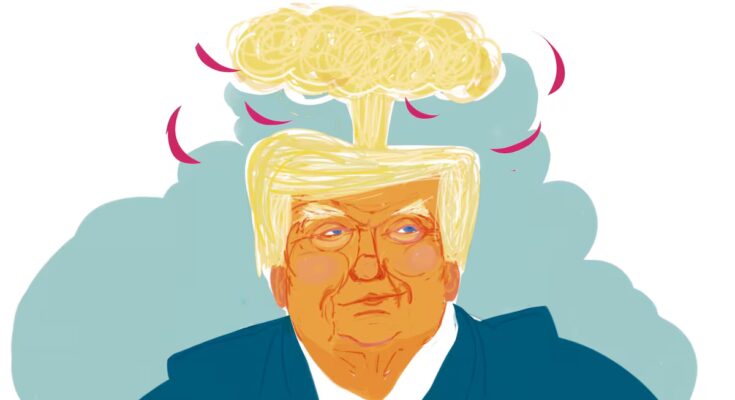Among the existential threats to humanity, the proliferation of nuclear weapons is the most evident since 1949, when the USSR carried out its first test, putting an end to the American monopoly and already openly starting the bipolar confrontation. It is therefore an issue on which it is appropriate to be very precise and avoid statements that could be misinterpreted by any of the nine existing nuclear powers. A warning that, once again, does not seem to be on Donald Trump’s agenda in light of his outburst on October 30, when he made two mistakes and uttered an ambiguous expression full of ominous omens.
On the one hand, he argued that the United States has more nuclear weapons than Russia, while it is known that the situation is exactly the opposite, although their exact number is not known (over 5,000 warheads in both cases, which represents approximately 92% of all existing on the planet). To this he added that he had directed the War Department to restart nuclear testing since others were already doing so, in a thinly veiled reference to Russia and China, when the Department of Energy is charged with that task and when the only country to have caused nuclear explosions (six) so far this century is North Korea (India and Pakistan did so in 1998, China and France in 1996, and Israel in 1979). In reality, what Vladimir Putin has done is simply announce the successful use of new launch vehicles that can potentially carry nuclear warheads, specifically the Burevestnik 9M730 intercontinental cruise missile (SSC-X-9 Skyfall, in NATO terminology) and the Status-6 Poseidon (Kanyon, in NATO jargon) underwater drone. Two weapons that had already been announced by the Russian president in 2018 and that, as far as we know, none of the launches carried out so far have carried nuclear warheads, nor is there any news of a nuclear test, something that Moscow had not done since 1990.
Of course, the launch of these nuclear-powered weapons, theoretically capable of penetrating any missile shield, is in itself worrying because it demonstrates the desire to continue perfecting the ability to strike any potential enemy with an unimaginable capacity for destruction. But something that the United States itself is also doing within the framework of the seven nuclear modernization programs approved in Barack Obama’s time (for example the B61-13 bomb) cannot be confused with a nuclear test, which Washington had not carried out since 1992. Therefore, if Trump’s words mean what he said literally and a new nuclear test is recorded (both underground and in the atmosphere), the discomfort immediately increases, in understanding that he decidedly despises what he signed in 1996, within the framework of Comprehensive Nuclear-Test-Ban Treaty (CTBT), although it has never ratified it. This is how Putin wanted to understand it in principle, who already in 2023 revoked the ratification of the CTBT that he had carried out in 2000, warning that in that case Moscow would behave accordingly.
The culmination of the absurdity of Trump’s announcement, if finally translated into facts, is that the United States does not need to carry out new nuclear tests; It already has more than a thousand, while Russia has 715 and China just 45. For some time, the technology accumulated in this field has allowed the nine nuclear powers to guarantee the operation of their arsenals and even to develop new weapons without having to resort to large-scale tests. They only need to (and they do) perform laboratory experiments at a subcritical level; before a chain reaction occurs. In other words, this implies that if Trump took the step of carrying out a new nuclear explosion we would not be faced with a gesture derived from a technical necessity, but rather with a destabilizing political gamble. A bet that would automatically further encourage the arms race with Russia, China and North Korea, first and foremost, interested in joining that trend. This would not only be a measure that would increase international tension, but it would also represent a mistake on Washington’s part, opening the door for its potential rivals to embark on a path that would allow them to overcome the disadvantage they currently have in that field, resulting from their lesser experience in simulated trials.
In this way, the CTBT would definitively become a dead letter, taking a further step towards weakening the framework already established during the Cold War to prevent the proliferation of nuclear weapons. Already in June 2002 the United States had decided to withdraw from the ABM Treaty on anti-ballistic missiles, thus eliminating a fundamental piece in stopping a race that had led both superpowers to accumulate tens of thousands of nuclear warheads in an attempt to saturate their rival’s defenses and thus ensure nuclear deterrence. As a result, Washington has stepped up efforts to equip itself with an anti-missile shield, leading to Trump’s announcement last May to create a seemingly impenetrable gold dome. It is no wonder that this has been one of the major driving factors for Russia to develop weapons that are supposedly undetectable and can penetrate any defense system.
Added to this is the abandonment by the United States (followed soon after by Moscow) of the Intermediate-Range Nuclear Forces (INF) Treaty in August 2019, reopening the way for both powers to once again deploy nuclear missiles on European soil with a range of between 500 and 5,500 kilometers. And it should not be forgotten that in February next year the extension agreed last year by the United States and Russia to temporarily keep START III (or New START) in force expires, limiting what both can maintain to 1,550 strategic nuclear warheads and 800 launch vehicles. If an extension or the signing of a new agreement is not reached, the prospects become even more ominous. To further complicate matters, Trump insists that China must also enter the process of reducing nuclear weapons, which Beijing flatly rejects because its arsenal is much smaller than that of Moscow and Washington and, therefore, it does not feel obliged to enter into any negotiations.
It is not a question of hiding the proliferative temptations of other nuclear powers; In fact, all of them are immersed in ambitious modernization programs, even dreaming of transforming them into battle weapons and not just deterrence, as has happened so far. But it is clear that in this century Washington has been the most interested in dismantling the system aimed at preventing proliferation, both vertical (the five nuclear powers recognized by the Non-Proliferation Treaty – USA, Russia, China, France and United Kingdom – are obliged to reduce their arsenals) and horizontal (as was the case of North Korea and could be the case of Iran and others), determined to equip itself with a protective shield that the available technology does not guarantee in any way.
Just in case, it is worth keeping an eye on Nevada, where the United States has major nuclear testing facilities.



